Keep smooth operations with a properly serviced clp engine.
Keep smooth operations with a properly serviced clp engine.
Blog Article
Just How a Clp Engine Can Boost Efficiency in Numerous Industries
The advent of CLP engines notes a substantial change in operational performance throughout various markets, driven by their capacity to maximize gas intake and reduce downtime. Industries such as manufacturing and logistics stand to gain considerably from their robust layout and regular power result, which guarantee to improve operations and improve efficiency. As organizations increasingly focus on sustainability along with effectiveness, the role of CLP engines comes to be a lot more essential. What stays to be seen is how these advancements will form the future landscape of commercial procedures and their influence on more comprehensive financial fads (clp engine).
Overview of CLP Engines
CLP engines, or Continuous Fluid Propellant engines, stand for a considerable improvement in propulsion technology, especially for area applications. These engines make use of a constant feed system that permits the sustained expulsion of propellant, leading to boosted effectiveness and efficiency contrasted to conventional solid or hybrid propulsion systems. By maintaining a consistent flow of liquid propellant, CLP engines can attain much more specific drive control, which is critical for maneuvering spacecraft in numerous mission scenarios.
The design of CLP engines integrates advanced products and ingenious gas management systems. clp engine. This causes reduced weight and boosted reliability, essential elements for long-duration area objectives. Furthermore, the constant operation lessens the threat of burning instability, a typical challenge in conventional rocket engines.

Advantages in Manufacturing
The production of Continuous Fluid Propellant (CLP) engines presents several notable benefits that boost both performance and cost-effectiveness. Among the main advantages is the streamlined manufacturing procedure, which lowers the complexity associated with conventional propulsion systems. By making use of fluid propellant, suppliers can accomplish better accuracy in engine efficiency, causing optimized energy result and minimized waste.
Additionally, CLP engines help with a greater level of modularity, enabling simpler integration into numerous manufacturing lines. This versatility can dramatically lower preparations and boost total functional flexibility. Making use of CLP technology also has a tendency to decrease the demand for comprehensive maintenance due to fewer moving components, which translates into minimized downtime and functional costs.

Applications in Logistics
Leveraging Continual Liquid Propellant (CLP) engines in logistics supplies you can try these out significant advantages in operational efficiency and dependability. These engines offer a durable service for numerous transportation demands, enabling the smooth motion of items throughout huge ranges. The integral design of CLP engines enables consistent power outcome, which equates right into smoother and more foreseeable transport routines.
One of the essential applications of CLP engines in logistics remains in heavy-duty freight transportation, where they can drive both ground and aerial automobiles. Their capability to preserve high efficiency under differing load problems makes sure that delivery timelines are met, thus improving consumer contentment. Additionally, CLP engines can be integrated into automated logistics systems, facilitating real-time tracking and optimizing course preparation.
Moreover, the longevity of CLP engines lowers maintenance downtime, enabling logistics business to optimize their operational capacities. This is especially useful in warehousing procedures, where efficiency in taking care of and transferring items is crucial. As logistics continues to evolve, the assimilation of CLP engines stands for a forward-thinking method that not just enhances efficiency yet likewise sustains the industry's expanding needs for integrity and rate.
Effect On Energy Effectiveness
Just How do Continual Liquid Propellant (CLP) engines boost energy efficiency in transportation? CLP engines utilize a constant circulation of fluid fuel, optimizing burning processes and preserving a stable drive result. This style minimizes power losses connected with conventional combustion engines, where gas shipment can differ and bring about inadequacies.
The continuous operation of CLP engines enables a more efficient thermal cycle, causing greater certain impulse compared to conventional engines. clp engine. This equates to decreased gas consumption for the exact same quantity of job done, substantially decreasing functional expenses across numerous transport sectors, including air clp engine travel and maritime markets
Additionally, the ability of CLP engines to keep ideal performance under varying load problems minimizes the requirement for frequent acceleration and slowdown, even more boosting gas performance. Improved power performance not only adds to cost financial savings but additionally results in reduce greenhouse gas exhausts, lining up with worldwide sustainability goals.
Future Trends and Innovations
Emerging improvements in Continual Fluid Propellant (CLP) engine innovation pledge to change the landscape of transport effectiveness and sustainability. As sectors pivot towards greener options, CLP engines stand at the forefront, integrating innovative products and layout methodologies that boost efficiency while minimizing environmental effect.
One of the most appealing trends is the fostering of crossbreed systems that combine CLP engines with sustainable power sources. This synergy can optimize fuel consumption and minimize discharges, aligning with worldwide sustainability goals. Moreover, developments in computational liquid characteristics (CFD) are facilitating the layout of more aerodynamically effective engines, leading to minimized drag and enhanced fuel effectiveness.
In addition, the growth of wise surveillance systems is set to enhance operational efficiencies. These systems leverage information analytics and IoT innovation to optimize engine efficiency in real-time, making certain that the engines run within their most effective parameters.
As research study remains to explore alternate propellant formulas-- such as biofuels and artificial gas-- the future of CLP engines looks promising. By using these technologies, markets can not just improve their that site efficiency however additionally add significantly to a cleaner, a lot more sustainable future in transport.
Final Thought
In conclusion, CLP engines represent a substantial innovation in performance across multiple sectors. The assimilation of sophisticated materials and less moving components minimizes maintenance requirements, while placement with sustainability objectives positions CLP engines as a crucial modern technology for the future.
Report this page